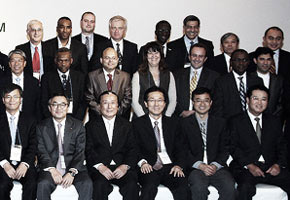

Seoul Science and Technology Forum brought together representatives of public research foundations from more than 35 countries to discuss how to promote sustainable growth
Seoul Science and Technology Forum brought together representatives of public research foundations from more than 35 countries to discuss how to promote sustainable growth.
Seoul Science and Technology Forum brought together representatives of public research foundations from more than 35 countries to discuss how to promote sustainable growth.

Seoul Science and Technology Forum brought together representatives of public research foundations from more than 35 countries to discuss how to promote sustainable growth
By Elton Alisson
Agência FAPESP – From October 6 to 7, 2011, Glaucia Mendes de Souza, professor at the Chemistry Institute of Universidade de São Paulo (USP) and a member of FAPESP coordination team for the Bioenergy Research Program (BIOEN), participated in the 2011 Seoul Science and Technology Forum in South Korea.
Sponsored by the Korea Research Council of Fundamental Science and Technology (KRCF), together with the Korea Institute of Science and Technology (KIST) and the Science and Technology Policy Institute (Stepi), the Forum brought together representatives of public research foundations from more than 35 countries to discuss how the Asian country can utilize Official Development Assistance (ODA) – a financial mechanism created by the Organization for Economic Cooperation and Development (OECD) – to promote sustainable growth among developing countries.
This was the first time that a representative of Brazil has participated in the annual Forum, which started in 2010. During her presentation, Souza highlighted that actions and the results of FAPESP’s Bioenergy Research Program, which was launched in 2008 with the objective of stimulating and articulating research activities and development utilizing academic and industrial laboratories to promote the advance of knowledge and its application areas related to production of bioenergy in Brazil.
Additionally, the researcher also stressed that 46% of the Brazilian energy grid is renewable, against the average 13% in developing countries and the 6% to 8% of developed countries. “I think that the representatives of countries participating in the event were a little bit surprised by my presentation showing how much Brazil has progressed toward sustainable development. They didn’t know that the country was that advanced in establishing a renewable energy grid and that it had a research program as robust as BIOEN in the area,” commented Souza in an interview with Agência FAPESP.
According to the researcher, after the presentation, representatives from Cameroon, Senegal and Tanzania showed interest in more information about the model developed in Brazil for sugarcane ethanol production to analyze the possibility of transferring it to these African countries that already grow sugarcane.
For this reason, she intends to organize a delegation of these countries to visit Brazil – specifically, São Paulo State, which is the largest sugarcane ethanol producer in the country – so that they can see firsthand research laboratories in the area, in addition to Brazilian mills.
“There has already been a Brazilian delegation to Africa to verify the availability of land in countries in the region that could be utilized to plant sugarcane, which found that there are perhaps 10 million hectares that could be utilized to this end. A study is needed to verify Africa’s potential for sugarcane ethanol production so that we can collaborate in this area,” said Souza.
One of the main objectives of the event, which brought together scientists, diplomats and representatives of government organs, was to prospect for financing opportunities in the participating developing countries in order to establish a technological pathway to promote sustainable development among these nations.
To this end, one of the Korean government’s ideas was to utilize the technologies that the Asian country is developing through institutions such as KIST – which is dedicated solely to providing long-term financing for high-risk projects, much like FAPESP does through its Research, Innovation and Dissemination Centers (CEPID) – and transfer them to these developing countries. During the event, however, no conclusion was reached on how this should be done because many of the many issues involved, such as intellectual property.
“What is clear in all of these global meetings that bring together many countries is that we still do not know the precise path that should be followed to implement ‘green’ growth. And it is difficult to determine what will be the mechanism to reach this objective because several of the developing countries present at the Forum, for example, indicated that none of the developed countries started off ‘green’, but rather as ‘dirty’ and are now telling developing nations that they must pursue ‘green’ growth,” sums up Souza.
To further the discussions occurring during the event, the final document produced by the Forum establishes a goal of creating a database on green science and technology to disseminate information, promote public-private partnerships and manage intellectual property rights in green industries in order to pave a technological pathway to sustainable growth.
Republish
The Agency FAPESP licenses news via Creative Commons (CC-BY-NC-ND) so that they can be republished free of charge and in a simple way by other digital or printed vehicles. Agência FAPESP must be credited as the source of the content being republished and the name of the reporter (if any) must be attributed. Using the HMTL button below allows compliance with these rules, detailed in Digital Republishing Policy FAPESP.





